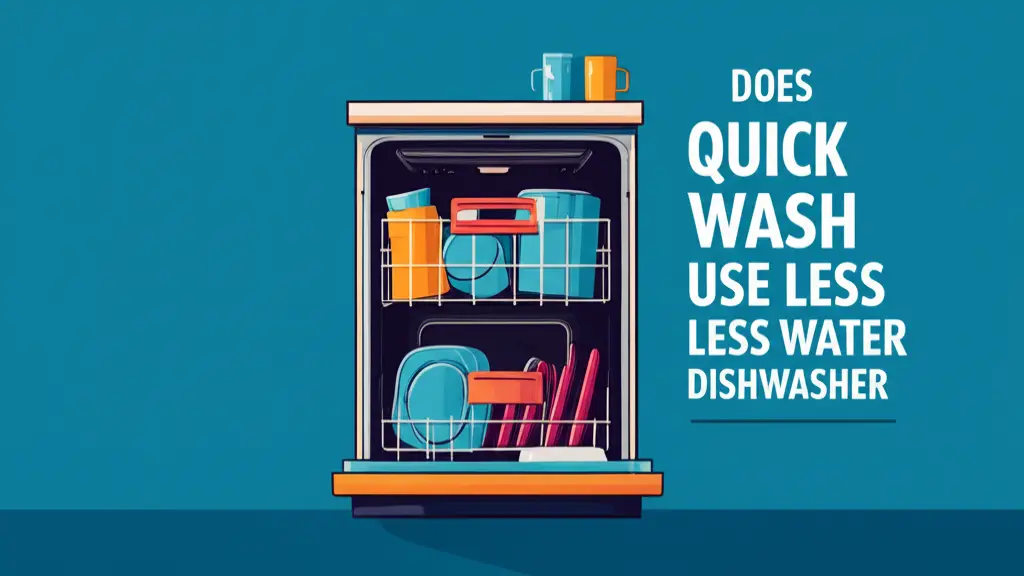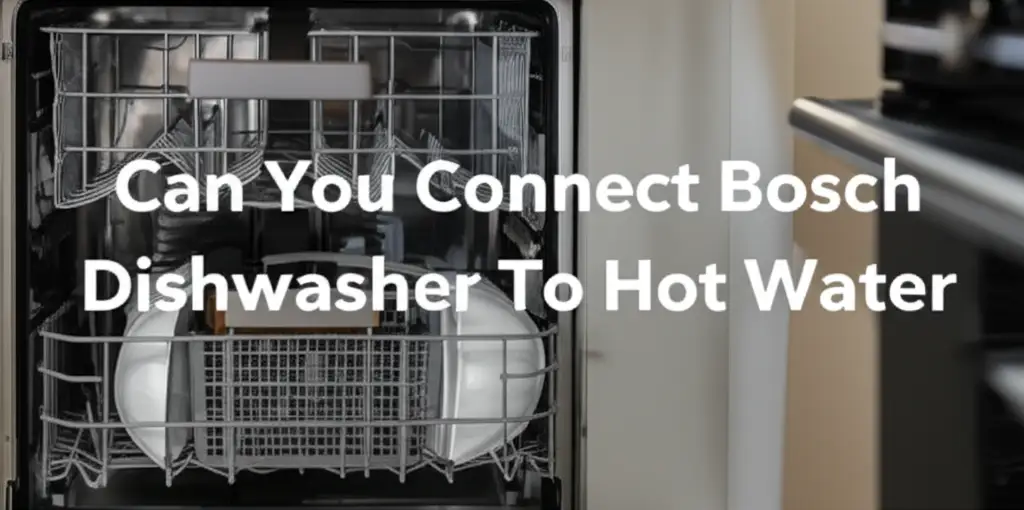· Todd Martin · Home Appliances · 16 min read
Does Quick Wash Use Less Water Dishwasher

Quick Wash Dishwasher Cycles: Do They Really Save Water?
Many people wonder about their dishwasher settings. They want to save resources. A common question is: Does quick wash use less water dishwasher models offer? This question comes up often. Understanding different dishwasher cycles helps us make smart choices. It impacts both our utility bills and the environment.
This article explores quick wash cycles. We will compare them to other common settings. We will look at how they use water and energy. You will learn when to use quick wash for the best results. We also discuss how to maximize your dishwasher’s efficiency overall.
Takeaway
- Quick wash cycles generally use less water than normal cycles.
- They also use less energy because they heat water for a shorter time.
- Quick wash is best for lightly soiled dishes or when you need dishes fast.
- Do not use quick wash for heavily soiled dishes; they may not get clean.
- Proper loading and maintenance help any cycle run efficiently.
Does quick wash use less water dishwasher models offer? Yes, in most cases, a quick wash cycle on your dishwasher uses less water compared to a standard or heavy-duty wash. This cycle is designed for speed and efficiency, achieving a quicker clean with reduced water intake and less energy for heating.
Understanding Dishwasher Cycles and Water Use
Dishwashers offer several wash cycles. Each cycle is for different types of dishes and soil levels. Standard cycles, often called Normal or Auto, adjust based on soil sensors. They use more water and energy to clean a full load thoroughly. Heavy-duty cycles use the most water and heat. They are for pots, pans, and very dirty items.
The amount of water a dishwasher uses varies by model. Newer dishwashers are more efficient. They use less water than older ones. Energy Star certified dishwashers meet strict efficiency standards. They save both water and electricity.
How Different Cycles Operate
- Normal Cycle: This is the most common setting. It runs for a longer time. It uses multiple rinses and higher temperatures. This cycle ensures dishes are clean. It handles average food residue.
- Heavy Duty Cycle: This cycle uses the most water and heat. It includes an intense pre-wash. It is for stubborn, baked-on food. Pots and pans often need this setting.
- Quick Wash Cycle: This cycle runs much faster. It uses less water and lower temperatures. It is for dishes that are not very dirty. We will explore this in detail soon.
- Eco Cycle: Some dishwashers have an Eco cycle. This cycle is designed for maximum efficiency. It uses less water and lower temperatures. However, it often takes longer.
Each cycle has a specific purpose. Choosing the right cycle helps save water. It also ensures clean dishes. Using a cycle that is too intense for lightly soiled dishes wastes water. Using a cycle that is too light for dirty dishes means rewashing them. This also wastes water.
Proper maintenance also affects water use. A clean dishwasher runs better. For instance, knowing how to clean the inside of a dishwasher helps it operate at peak efficiency. Blockages or dirty components can make the machine work harder. This can lead to increased water usage over time.
Quick Wash Explained: How It Differs
The quick wash cycle goes by many names. You might see “Express,” “Speed,” or “Light Wash.” This cycle is designed for speed. It completes a wash in a short time. This is usually 30 to 60 minutes. Standard cycles can run for 2 to 4 hours. The main difference is the cycle’s length and intensity.
Quick wash cycles skip or shorten certain phases. They often skip the pre-rinse phase. They use fewer rinses overall. The water temperature might be lower. The drying time is also often shorter or absent. These changes mean less water is pumped and heated. This saves both water and energy.
Core Differences in Operation
- Shorter Duration: This is the most obvious difference. A quick wash finishes much faster. This rapid completion is great when you need dishes quickly.
- Less Water Volume: Quick wash cycles use a smaller amount of water per fill. They also have fewer fill-and-drain cycles. This directly answers the core question.
- Lower Temperature: The water may not heat as much. This saves energy. However, it might not sanitize as effectively.
- Reduced Rinsing: Fewer rinse cycles mean less water consumed. It also means less time spent running.
- Less Drying Time/No Heat Dry: Some quick cycles skip the heat dry entirely. This saves energy. Dishes might need air drying.
A quick wash cycle is not for every load. It is specialized. It aims for a fast clean. It does not aim for the deepest clean. Knowing how long does a dishwasher take to finish on different settings helps you manage your time and expectations. For quick cycles, that time is significantly reduced.
Factors Affecting Quick Wash Water Consumption
While quick wash cycles generally use less water, several factors influence the exact amount. Not all quick wash cycles are identical. Dishwasher design, model year, and even how you load the machine play a role. Understanding these helps optimize your water usage.
Newer dishwashers are engineered for efficiency. They use smart sensors. These sensors detect soil levels. They adjust water use accordingly. An older model’s quick wash might still use more water than a new eco-friendly normal cycle. Always check your appliance manual for specific details.
Key Influencing Factors
- Dishwasher Model and Age: Modern dishwashers are more water-efficient. They use advanced spray arms and filtration. An Energy Star certified quick wash uses less water. Older models may not be as efficient.
- Sensor Technology: Many modern dishwashers have soil sensors. If the quick wash detects unexpected soil, it might extend the cycle. It might use slightly more water to compensate. This is rare for a true quick wash, but possible.
- Water Pressure: Consistent water pressure helps the dishwasher operate efficiently. Low pressure can sometimes make cycles take longer. This could potentially increase water use.
- Loading Habits: Overloading or improper loading can hinder water circulation. Water might not reach all dishes. This can lead to rewashing. This wastes water, regardless of the cycle.
- Dish Cleanliness Before Loading: Quick wash is for lightly soiled items. If dishes have stuck-on food, the quick wash might not clean them. This means you have to rewash them. This definitely wastes water. Pre-scraping food off dishes is always a good idea. You do not need to pre-rinse excessively, but remove large food particles.
Regular maintenance helps maintain efficiency. Cleaning the dishwasher filter helps. If the filter is clogged, water cannot circulate properly. This forces the dishwasher to work harder. Learning how to clean filter in dishwasher can prevent inefficient water use. Keeping your appliance clean means it performs better. It also lasts longer.
Comparing Quick Wash to Normal and Eco Cycles
When aiming for water and energy savings, comparing cycles is important. Quick wash uses less water than a normal cycle. It also uses less energy for heating. However, it is not always the most water-efficient or energy-efficient option. The “Eco” or “Economy” cycle often wins for overall efficiency.
The trade-off for quick wash is cleaning power. Because it uses less water, lower temperatures, and shorter wash times, it is less effective on heavily soiled dishes. The Eco cycle, while sometimes longer, uses lower temperatures and optimized water delivery for a truly efficient clean.
Understanding the Differences
Water Consumption:
- Quick Wash: Uses the least amount of water per cycle. Ideal for lightly soiled dishes.
- Normal Wash: Uses more water than quick wash. It is balanced for average loads.
- Eco Wash: Often uses less water than normal. It focuses on gentle washing. It might use even less water than quick wash in some models, especially for a full load, due to highly optimized spray patterns and longer soak times at lower temperatures.
Energy Consumption:
- Quick Wash: Uses less energy. This is because it heats water for a shorter time. It also usually skips heated drying.
- Normal Wash: Uses more energy than quick wash. It heats water to higher temperatures. It also runs longer.
- Eco Wash: Designed for maximum energy efficiency. It often uses lower wash temperatures. It extends the cycle time to compensate for the lower heat. This allows enzymes in detergent more time to work.
Cleaning Performance:
- Quick Wash: Best for lightly soiled items. Think glasses, mugs, and plates with minimal food. It may not remove tough stains.
- Normal Wash: Excellent for everyday dirty dishes. It removes most food residues effectively.
- Eco Wash: Good for typical loads too. It takes longer. But it cleans well while saving resources.
Cycle Duration:
- Quick Wash: Fastest cycle (30-60 minutes).
- Normal Wash: Moderate duration (1.5 - 2.5 hours).
- Eco Wash: Longest duration (2 - 4 hours or more).
My goal is always to run the most efficient cycle possible. I consider the dirtiness of my dishes. If they are just lightly used, quick wash is perfect. If they are dinner plates with dried food, I opt for normal. If I’m not in a hurry, Eco is my top choice for saving resources. Knowing how to clean dishwasher with vinegar can also contribute to efficiency by keeping the spray arms and jets clear for optimal water distribution.
When to Choose Your Dishwasher’s Quick Wash
Choosing the right dishwasher cycle is key to saving water and energy. The quick wash cycle is a specialized tool. It is not for every load. Understanding its limitations helps you use it effectively. Using quick wash inappropriately can lead to dirty dishes. This means you have to rewash them, which wastes water.
I typically use the quick wash for specific situations. It is great for certain types of dishes. It is also perfect when I am short on time. Here are some scenarios where quick wash shines:
Ideal Situations for Quick Wash
- Lightly Soiled Dishes: This is the primary use. Think breakfast dishes or glasses from a gathering. They have minimal food residue.
- Mostly Clean Dishes: Sometimes, dishes just need a rinse and light wash. This could be items from a cupboard that collected dust. It could also be dishes that were pre-rinsed very well.
- Needing Dishes Quickly: If you are hosting a party and need serving platters again fast, quick wash is your friend. It provides a fast turnaround.
- Before Guests Arrive: I sometimes run a quick wash with lightly used dishes before guests come. This makes space and ensures clean items are ready.
- Washing Delicate Items: Items that do not need intense scrubbing. Quick wash provides a gentle clean. This can include certain glassware or plastic containers that are top-rack safe.
When to Avoid Quick Wash
- Heavily Soiled Dishes: Quick wash does not have enough time or water for stubborn food. Baked-on grease or dried pasta will not come clean.
- Pots and Pans: These items usually require intense scrubbing. They need higher temperatures and more water. Use a heavy-duty cycle instead.
- Full Loads with Mixed Soil Levels: If your load has a mix of very dirty and lightly dirty items, quick wash might clean the light items. However, the dirty ones will remain unclean. This necessitates rewashing.
Always prioritize getting your dishes clean in one go. If you are unsure, err on the side of a longer, more thorough cycle. It might use slightly more water initially, but it saves water in the long run by avoiding rewashes. Cleaning your dishwasher regularly, like performing a deep clean for a dishwasher, ensures it can effectively clean dishes on any cycle, preventing the need for rewashing due to machine inefficiency.
Maximizing Efficiency with Any Dishwasher Cycle
Saving water and energy goes beyond choosing the right cycle. Your habits and maintenance routines play a huge role. Even with a quick wash, you can still improve efficiency. My goal is always to get the most out of my dishwasher while using the fewest resources.
Small changes in how you load and maintain your appliance add up. These practices benefit all wash cycles. They extend the life of your dishwasher. They also keep your dishes sparkling clean.
Best Practices for Dishwasher Efficiency
- Scrape, Don’t Rinse: Remove large food particles from dishes before loading. Do not pre-rinse heavily under running water. Modern detergents and dishwashers handle most food residue. Pre-rinsing wastes more water than the dishwasher uses for an entire cycle.
- Load Fully: Run your dishwasher only when it is full. A half-empty dishwasher uses almost the same amount of water and energy as a full one. Maximize each wash.
- Load Correctly: Follow your dishwasher’s loading instructions. Proper loading ensures water sprays reach all surfaces. This prevents rewashing due to poor cleaning.
- Use the Right Detergent: Use high-quality dishwasher detergent. It should be suitable for your water hardness. Proper detergent ensures effective cleaning. This reduces the need for rewashing. Consider if you ever wonder what can you use instead of dishwasher tablets for alternative options.
- Choose the Right Cycle: As discussed, match the cycle to the soil level. Quick wash for light loads. Normal for everyday. Eco for maximum savings when time permits.
- Skip Heated Dry: Most dishwashers have a heated dry option. It uses a lot of energy. Open the dishwasher door after the wash cycle finishes. Let dishes air dry. Many models have an “air dry” or “energy saver” option.
- Regular Maintenance: Keep your dishwasher clean. Clean the filter regularly. Check spray arms for blockages. This ensures optimal water pressure and distribution. A clean dishwasher performs better. It also uses water more efficiently. Learning how to clean your dishwasher DIY helps maintain its efficiency over time. This includes simple steps that keep it running smoothly.
- Check Water Temperature: Ensure your water heater is set to 120°F (49°C). This is hot enough for effective cleaning. Anything higher wastes energy. Dishwashers often have their own water heating element.
By following these tips, you optimize your dishwasher’s performance. You save water. You also save energy. This contributes to a more sustainable home.
Modern Dishwasher Technology and Water Savings
Dishwashers have come a long way. Modern appliances are incredibly efficient. They use much less water than hand washing. They also outperform older models significantly. New technologies focus on smart water use and powerful cleaning.
Manufacturers constantly innovate. They aim to reduce environmental impact. They also aim to lower utility costs for consumers. If you are buying a new dishwasher, look for specific features. These features directly relate to water and energy savings.
Innovations for Water Efficiency
- Soil Sensors: These intelligent sensors detect how dirty your dishes are. The dishwasher then adjusts water use and cycle length. This ensures only the necessary water is used. It prevents over-washing lightly soiled loads.
- Improved Spray Arms and Nozzles: Modern designs ensure water reaches every dish. They use targeted jets and optimized spray patterns. This minimizes wasted water. It ensures thorough cleaning.
- Multiple Filtration Systems: Advanced filters remove food particles more effectively. This keeps the wash water cleaner. It allows the dishwasher to reuse water for certain rinses. This reduces overall fresh water intake. Cleaning your filter regularly is important. Knowing where is filter in Samsung dishwasher or any brand helps you maintain this crucial component.
- Low Water Wash Cycles: Beyond quick wash, some models have specific “light” or “half load” cycles. These are designed for smaller amounts of dishes. They use even less water.
- Heat Exchangers and Condensation Drying: Instead of a heating element, some dishwashers use a heat exchanger. This uses the heat from the wash water to dry dishes. It is very energy efficient. It also means no hot air is vented, which is safer for countertops.
- Smart Home Integration: Some dishwashers can connect to smart home systems. You can monitor water and energy use. You can also start cycles during off-peak energy hours. This saves on electricity costs.
- Adjustable Racks: While not directly about water, flexible racks help. They allow for better loading. This ensures water can properly reach all items. This prevents rewashing, which saves water.
Investing in an Energy Star certified dishwasher is a wise choice. It saves money in the long run. It also reduces your environmental footprint. These appliances are designed to be efficient. They clean dishes while respecting resources. They are a testament to how far appliance technology has come in saving both water and energy in the home.
Frequently Asked Questions About Quick Wash Cycles
What is the main purpose of a quick wash cycle?
The main purpose of a quick wash cycle is to clean lightly soiled dishes quickly. It is ideal for items like glasses, mugs, or plates with minimal food residue. This cycle saves time when you need dishes fast. It is not designed for heavily soiled pots or pans.
Is quick wash as effective as a normal cycle for cleaning dishes?
No, a quick wash cycle is not as effective as a normal cycle for heavily soiled dishes. It uses less water, lower temperatures, and a shorter wash time. This means it may not remove stubborn, baked-on food. Use it only for lightly soiled items to ensure proper cleaning.
Does quick wash save energy in addition to water?
Yes, quick wash cycles typically save energy. They heat water for a shorter period compared to normal or heavy-duty cycles. Many also skip the heated drying phase. This combination of reduced water heating and less drying significantly lowers energy consumption.
Can I use quick wash for every dishwasher load?
You should not use quick wash for every dishwasher load. It is only suitable for lightly soiled dishes. Using it for dirty items will result in poorly cleaned dishes, requiring a rewash. This wastes water and energy. Always match the cycle to the soil level of your dishes.
How much water does a quick wash cycle typically use?
The exact amount of water varies by dishwasher model. However, a quick wash cycle typically uses significantly less water than a normal cycle. For example, a quick wash might use 3-5 gallons, while a normal cycle could use 6-8 gallons or more, depending on the model and year of manufacture.
What are the signs that I should not use quick wash?
You should not use quick wash if your dishes have dried-on food, baked-on grease, or excessive food particles. If the dishes feel sticky or have visible residue, a normal or heavy-duty cycle is more appropriate. Using quick wash on these items will lead to unsatisfactory cleaning results.
Conclusion
Understanding your dishwasher’s cycles helps you make smart choices. It impacts both your utility bills and the planet. Does quick wash use less water dishwasher models incorporate? The answer is generally yes. Quick wash cycles use less water and energy than standard cycles. They are designed for speed and efficiency. They are best for lightly soiled dishes or when you need items cleaned fast.
However, quick wash cycles are not a universal solution. They might not effectively clean heavily soiled items. This would require rewashing, which ultimately wastes water. My recommendation is to choose the cycle that best matches your dishes’ soil level. Use quick wash for light loads. Opt for normal or eco cycles for typical or very dirty dishes. Regular maintenance and proper loading habits also maximize efficiency across all cycles.
By adopting these practices, you can make your dishwashing routine more sustainable. You will save water and energy. You will also keep your dishes sparkling clean. Invest in smart appliance usage today.
- quick wash dishwasher
- dishwasher water usage
- energy efficiency
- dishwasher cycles
- appliance tips
- water saving
- eco-friendly dishwashing





